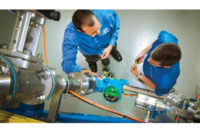
When asked "What methods has your company implemented to improve productivity and throughput over the past five years?," 75 percent of respondents toFood Engineering's Best Manufacturing Practices Survey (FE, February 2000) reported "improved employee/operator training."
As the national unemployment rate has hovered at a 30-year low of 4 to 4.1 percent over the past six months, food manufacturers found another motive for improving their training programs: attracting and retaining new employees. Survey respondents report using a growing mix of both internal and external resources to expand their training programs. Only 7 percent reported that their companies conduct no formal training.
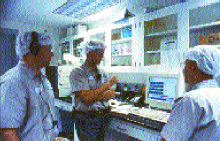
Bottom-line focus for community resources
Community resources at local, state and federal levels can support food manufacturers with hiring and training services as well as with loans or grants to finance training, said John Conrath, director of training, business and industry services at Northern Illinois University (NIU), at the 76th annual meeting of the American Society of Baking (ASB) March 7 in Chicago.But companies must focus on the bottom line. "Many lose focus...in the chase for resources such as state grants," Conrath cautioned. "Companies should only form partnerships and seek community resources that can add value to business goals." This means boosting worker knowledge and skills to perform tasks critical to achieving business goals.
NIU support, for example, is based on a training model consisting of three parts: needs analysis; training and performance support; evaluation. The needs analysis identifies worker tasks most critical to supporting company business goals, prioritizes those tasks and then identifies the knowledge and skills needed to perform those tasks.
Training support covers a wide range, including basic skills, technical skills, computer skills, regulatory compliance and continuous improvement. These can be delivered in varying ways, including traditional classroom and on-the-job methods; computer-based media such as CDs and intra/internet; distance learning and workshops.
Most funding agencies require compliance to measurement criteria such as cost-per participant, employment level, company contributions and number of new hires trained. NIU evaluates training results based on financial, operational, customer-satisfaction and employee improvements.
Local community organizations can provide trainable people through direct referral and pre-employment training. The Chicago area, for example, has many such organizations, including minority and immigrant-assistance groups and the Mayor's Office of Workforce Development. Most of these resources are available at no cost or a subsidized cost.

One example of a food company using NIU services is Peerless Confection Co., a Chicago manufacturer of hard candies employing about 100 people. Many have been with the company for 25 years and more, says President Russ Lyman, "but many were not born in the U.S., so English is not their primary language." NIU first assessed employee reading and math skills, then started classes for English as a second language (ESL) 18 months ago for about 60 percent of the Peerless workforce. Participating employees attend one of two ESL classes totaling eight hours per week, conducted on-site on company time. Results: "Employees have gained a lot of confidence, communications have improved and they're more willing to make suggestions and discuss things with management," says Lyman. Some continue their education on their own time at an advanced course conducted on-site.
For Peerless supervisors, NIU conducted a 12-week course "covering everything from diversity training to role playing to problem solving," Lyman continues. He plans further NIU training in problem-solving and quality management for all hourly employees. NIU also helped Peerless acquire matching funds through a Chamber of Commerce program to cover some training costs, and further helped the company prepare an application for a state grant.
Using its own resources, Peerless conducts eight to 12 hours of formal safety training annually for all employees. For technical training, operators -- organized into five-person line teams -- are trained on the job through an informal yet "fairly structured" apprenticeship program of several levels leading over two to three years to the position of candy maker. The company also sends several supervisors and QC technicians to the two-week candy-making course conducted annually at the University of Wisconsin by the National Confectionery Association.
Although turnover is low, Peerless typically hires 10 to 12 people per year "so we do have to recruit," says Lyman. The company seeks recruits through community organizations and other sources but has recently been "lucky" to find experienced candy makers with the shutdown of some facilities formerly operated by Favorite Brands, recently acquired by Nabisco.
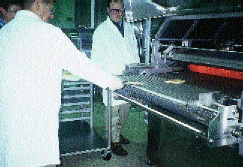
Industry resource offers wide scope
Several food-industry organizations offer training courses but none offers the scope provided by the American Institute of Baking (AIB), based in Manhattan, Kan.AIB this year offers four resident courses at Manhattan,11 correspondence courses, more than 120 seminars (some in Spanish) at locations across the U.S., and five videotape seminars plus CD-ROMs in baking technology and HACCP. Many AIB seminars and correspondence courses apply beyond the baking industry and are utilized by manufacturers in all segments of the food industry. Examples: Advanced HACCP, plant sanitation, electrical troubleshooting, pest control, freezing technology, PLC fundamentals and maintenance engineering. Kirk O'Donnell, vice-president of education at AIB, estimates that AIB courses reach nearly 2,000 students per year. "Our core business is the baking industry, but probably only a little more than half our students are from baking," he observes.
To help member companies recruit and train new employees, AIB has applied for a U.S. Dept. of Labor grant to fund a pilot program in one city to recruit prospective bakers, test them to determine their training needs, develop training programs to fill the skill gaps and place them as interns with bakery firms. If the pilot succeeds, O'Donnell envisions extending the program to the nation's 10 largest population centers. "We figure we can reduce per-person recruiting costs for the baking industry nationwide by about 30 percent," he adds.
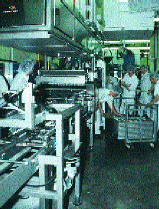
Gonnella is starting to use CD training, he adds, and utilizes vendor programs from time to time to train people in electronics and on specific equipment.
Recruiting in today's high-employment environment "has been extremely difficult," says Pasquesi. "We tap into every conceivable resource," including the Internet, newspapers, schools, community organizations and the Illinois Employment Training Center, which outplaces people from downsized companies. Gonnella also plans to establish ESL training through NIU, he adds.
Pasquesi views training as an incentive to recruiting. "People are looking for opportunities not only to secure a position but to become trained and skilled in a position," he observes. "That's the difference between a job and a career."
Pay-for-skills adds incentive
Among the training methods surveyed inFood Engineering's Best Practices study, on-the-job training (OJT) -- not surprisingly -- is the most common, with 95 percent of respondents using this method. But OJT is becoming more structured with performance-based training and in some cases pay-for-skill programs. Skill-based pay seems to be a growing trend among food manufacturers: 23 percent of survey respondents report using this method.Paying for skills may help a company attract and retain employees, said Jim Ervin, manager of the Schewebel Baking Co. plant in Cuyahoga Falls, Ohio, at the ASB Conference March 7. Skill-based pay links pay increases to the number or depth of skills that an employee learns and is able to perform. Employees are hired at a base level that allows them to develop proficiency in a core set of tasks. The company then encourages the employee to learn additional skills and provides training. When the employee demonstrates a satisfactory level of competency in a specific skill or set of skills, his or her pay is increased to a predetermined amount. Skill-based pay differs from traditional pay systems in that it rewards a person for what he or she is worth rather than what the job is worth, Ervin noted.
Employer benefits include reduced cost per unit through greater efficiencies, quicker problem solutions and less waste of time and material. Employee benefits include greater job security, increased self-esteem from mastering new skills and the opportunity to enhance earnings.
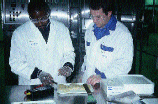
Sidebar: Vendor offers training outsource
Fifty-three percent of respondents to FE's Best Practices Survey use vendor programs among their training methods. One supplier offering extensive training is Stein-DSI, a unit of FMC FoodTech based in Sandusky, Ohio. Stein, a manufacturer of cutting, coating and cooking systems, conducts technical training at its 30,000-sq.-ft. Food Processing Technology Center, which is equipped for classroom instruction and practical training on commercial-scale equipment. Stein courses, scheduled at various times throughout the year, include: Basic Oven Processing, Basic Coating & Frying, Advanced Cooking, Sanitation, GCO Oven Maintenance and Basic Industrial Refrigeration. The center also offers custom ized operator and maintenance training "where you want it, when you want it," says Bob Swackhamer, manager of technical training at Stein.Food Engineering joined a class of nine students at Sandusky in late March for one day of Stein's four-day course in Advanced Cooking Applications. Students represented Dutch Quality House, a poultry-processing unit of Continental Grain Co., and J. M. Schneider, Canada's largest meat processor. The morning session included a class by Stein Food Scientist Dr. Don Burge on the physical and chemical changes that occur in foods during cooking, and a class by Dr. Lynn Knipe of Ohio State University covering thermal measurements, rapid microbiological detection methods and HACCP. During the afternoon, using boneless chicken breasts as the product, students evaluated the effects of alternate cooking processes and equipment sequences on process variables such as time, temperature and throughput, and on product variables such as color, yield, moisture and core temperature.
Equipment included a Jet Stream Oven, a GYRoCOMPACT spiral oven, a spiral Stein Checker steam oven, a PRoGRILL belt grill, a product flattener and a Char-Marker.
At the end of the course, students reported on product variables resulting from their experiments. Commentingon the value of the course, one remarked: "We believe it gives us a competitive edge."
